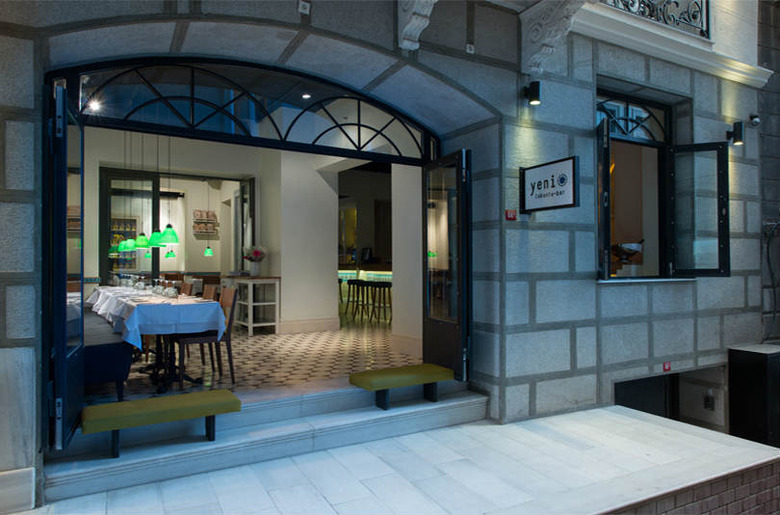Two Takes On Turkish Food In Istanbul
The heart of the Istanbul district of Beyoğlu — also known by its old name of Pera — is the city's Latin Quarter or West Village, a bustling warren of little streets filled with shops and restaurants that range from funky to chic.
Two of the best places to eat in this lively neighborhood, some three or four blocks apart but very different in style, are Asmalı Cavit and Yeni Lokanta. The first is a venerable meyhane, or tavern, where the menu is classic, old-style Turkish; the latter is a cool contemporary hotspot serving a modern but tradition-based menu created by one of Istanbul's most creative chefs.
Asmalı Cavit, on steep, crowded Asmalımescit Caddesi, is a two-level place, with a narrow bar area with some tables downstairs and a larger dining room on the second floor. Proprietor Cavit Bey welcomes guests with a smile (the Istanbul Eats website, noting that he looks after every customer personally, adds "We have yet to hear him say "maalesef" ["unfortunately" in Turkish] to a request"). Service is friendly and bistro-efficient.
Waiters speak English, but you don't need to talk — just point — when the two-tiered mezze cart comes to the table. Some 20 or 25 delights are offered, among them a babaganoush-like purée of smoked eggplant called patlican salatasi, a hash of spicy red peppers and tomatoes, a block of fava bean purée scattered amply with dill, and the petals of salt-cured tuna called lakerda. The essential hot appetizer here is the börek, perfectly crisp meat-and-onion-filled pastries, moist and full of flavor.
The köfte, or meatballs (actually more tubular than ball-like in shape) are moist and just salty enough, and there's a selection of simply cooked fresh fish as well as grilled lamb chops and both lamb and chicken kebabs. But during hamsi (fresh anchovy) season, from September through the end of the year, these are not to be missed. Asmalı Cavit prepares these firm, delicious little creatures, fished in the Black Sea, by pressing two butterflied and boned fish together, dredging them in cornmeal, and frying them in olive oil; they're good enough to banish from your mind any memory of those intensely saline, slightly gritty, dark little things that come in oval cans.
Yeni Lokanta
Yeni Lokanta — the name means "New Restaurant" — takes traditional Turkish dishes of the kind Asmalı Cavit does so well and updates them, without getting silly about it. The chef–owner here, Civan Er, first attracted attention cooking at Changa, considered to be the city's first truly "modern Turkish" restaurant. In the summer of 2013, he decamped to open this place of his own, just off the main shopping street called Istiklal Caddesi. In the small, tile-floored dining room, illuminated with hanging green lights, and in the adjacent bar (where the specialty seems to be potent bloody marys), Er offers both small and large plates, as well as two mezze selections of three items each, some of them smaller versions of more substantial offerings. [pullquote:right]
Er obviously sources great ingredients — his dishes taste vividly of whatever they're made from — and treats them with intelligence and respect. Simple preparations like yogurt and zucchini flower fritters, spicy green beans with "burnt" (scalded) Denizli yogurt, or grilled meatballs with halloumi cheese and wood-roasted vegetables are impeccable. Tender grilled octopus with purslane and smoked eggplant salad rescues this overused octopod from cliché. Manti filled with dried eggplant and cloaked in Antakya yogurt may be the best version of this Turkish ravioli-like pasta in Istanbul. Absolutely not to be missed, though, is the spicy Antep sucuk, or sausage, flavored with garlic, walnuts, and red Antep pepper and what must be another dozen spices, all perfectly in balance. This is sliced thin, fried crisp and deep brown, and served over puréed borlotti beans laced with olive oil, and it's so satisfying in both flavor and texture that you might want to save it for last. There's excellent homemade bread, served in handsomely shopworn copper bowls, to mop up any traces of the beans or sausage juices that might remain.
Any traveler who has even a brief stop in Istanbul can get a very good idea of the goodness and variety of Turkish food by dining at these two places.

